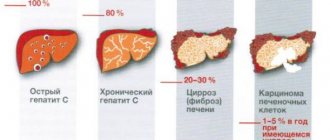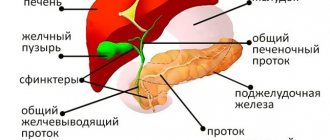The liver is an unpaired organ of the abdominal cavity, the largest gland in the human body, which performs a variety of functions.
- The liver neutralizes toxic substances that enter it with blood from the gastrointestinal tract.
- It also synthesizes the most important proteins in the blood and produces glycogen and bile.
- The liver is involved in lymph formation and plays a significant role in metabolism.
Liver tests will tell you whether your liver is functioning correctly or incorrectly.
“Liver tests” are a set of blood tests that are performed in order to diagnose liver and gallbladder pathologies in a patient (in fact, that’s why they got their name). Typically, this test is performed as part of a biochemical blood test. Based on liver tests, the doctor can make a conclusion about how much the liver is affected, whether the disease is acute or chronic, how the treatment affected the liver, how active the process is in cirrhosis or hepatitis.
Liver test analysis includes the following indicators:
- alanine aminotransferase (ALT);
- aspartate aminotransferase (AST);
- total bilirubin and its fractions;
- gamma glutamyl transferase (GGT);
- alkaline phosphatase.
- total protein;
Total protein shows the concentration of protein in the blood. A decrease in this indicator may indicate severe liver disease, since in this case liver cells begin to synthesize less protein.
AST and ALT are enzymes for the synthesis of which the liver is responsible. Separately from each other, changes in the values of these indicators cannot indicate the presence of any pathology; they must be assessed in conjunction with other indicators. Increased AST levels may occur with hepatitis or liver tumors; ALT - in acute liver damage, and this value shifts long before the patient develops the first noticeable symptoms.
An abnormal alkaline phosphatase (ALP) level may indicate the presence of a malignant liver tumor or the development of cholestasis. But we can talk about these diseases only if the values for all enzymes that the liver produces are elevated. If only alkaline phosphatase is elevated, most likely the cause is a disease of some other organ.
Deviation from normal bilirubin is the main indicator that the patient is developing liver failure. However, bilirubin can also change in other diseases, such as hepatitis, blockage of the bile ducts. Deviations in tests can be caused by a strict diet, therapeutic fasting, or poisoning with medications that are toxic to the liver.
There are 2 fractions of bilirubin:
- direct bilirubin;
- indirect bilirubin.
It is important to determine their indicators with an increased value of total bilirubin.
An increase in GGT levels may indicate stagnation of bile, disruption of its outflow, inflammation, tumors and the consequences of excessive alcohol consumption. This enzyme may also be increased by the use of certain medications and drugs.
Liver tests
During almost any comprehensive examination, tests are required to study liver function. These include studies that help assess the general functional state of the organ, as well as bilirubin synthesis, bile production and many other indicators.
The liver is the most important organ in whose cells many types of metabolism take place. Hepatocytes - enzymes of liver cells - are directly involved in protein metabolism. And if there are problems with the liver, these hepatocytes are massively destroyed. Liver cell enzymes are of two types - AST and ALT. If we are talking about an increase in ALT in the liver test, this indicates serious damage to the most important organ. If the level of AST in the blood is elevated, we can confidently talk about muscle damage, myocardial infarction or hemolysis of red blood cells. If the levels of the above enzymes exceed the norm by 5-10 times, the patient is diagnosed with acute viral hepatitis. If the level of excess is 1.5-2 times, we are talking about chronic hepatitis. Patients with alcoholic hepatitis, liver cirrhosis, or organ metastases also experience a significant increase in AST levels in the liver test.
There are specific enzymes that help evaluate the biliary function of the liver and biliary tract - alkaline phosphatase and GGTP. If the levels of both enzymes are elevated at the same time, doctors can safely rule out bile duct obstruction (in the case of cholelithiasis). If a patient is diagnosed with a high level of GGTP during the examination, this may indicate cirrhosis of the liver or metastatic formations present in it. An increase in GGTP by 2-5 times may indicate the presence of viral hepatitis in the body. And the level of alkaline phosphatase increases if we are talking about serious pathologies of the intestines and bones.
In addition to changes in the levels of various liver enzymes in the blood, during hepatic jaundice and biliary obstruction, the amount of total bilirubin in the body increases significantly. Problems with the synthesis of bilirubin are characterized by hereditary Gilbert's syndrome - during this disease the patient lacks the enzyme that neutralizes indirect bilirubin.
Many people do not know that a huge number of drugs have hepatotoxic effects. Taking common paracetamol leads to serious damage to liver cells. This is why it is so important to regularly evaluate liver function in order to prevent the development of toxic hepatitis and other serious pathologies of the most important organ.
Only the attending physician can prescribe specific tests and interpret their results. Contact only trusted and experienced specialists in their field.
Symptoms
Problems with the liver become clearly evident only in the case of an acute illness, when the liver can no longer cope with toxins. Poisoning occurs, which is manifested by the following symptoms:
- the whites of the eyes and skin acquire a yellowish tint (jaundice);
- stool becomes pale;
- urination becomes more frequent and urine becomes orange in color;
- palms become bright red;
- the stomach increases in size;
- skin itching appears, worsening at night.
The condition of the liver affects the functioning of the kidneys, brain, and gastrointestinal tract. Damage to the liver can lead to very serious complications, including death. At the first suspicion of the disease, you should immediately consult a doctor and undergo an examination. Ultrasound examination (ultrasound) of the liver - allows you to assess the size of the liver and its condition.
Liver tests interpretation
Normal liver indices depend on the age and gender of the patient. The doctor does not always make a “verdict” after alarming abnormalities in the tests have been noted - often the test is repeated after a certain period of time.
The norm of liver enzymes is given in the table, which can be viewed below:
| Indicators | Men | Women |
| AST | Up to 47 U/l | Up to 31 U/l |
| ALT | Up to 37 U/l | Up to 31 U/l |
| GGT | Up to 49 U/l | Up to 32 U/l |
| Total bilirubin | 8.5 - 20.5 µmol/l | 8.5 - 20.5 µmol/l |
| Direct bilirubin | Up to 15.4 µmol/l | Up to 15.4 µmol/l |
| Bilirubin indirect | Up to 4.6 µmol/l | Up to 4.6 µmol/l |
| Total protein | 60 - 80 g/l | 60 - 80 g/l |
| Albumen | 40-60% | 40-60% |
Where can I get liver tests?
You can find out everything about the condition of your liver and diagnose the disease in the Sinevo medical laboratory in Minsk, Gomel, Brest, Grodno, Vitebsk, Mogilev, Bobruisk, Baranovichi, Soligorsk, Slutsk, Polotsk, Novopolotsk, Orsha, Zhlobin, Svetlogorsk, Molodechno, Pinsk, Borisov , Rechitsa, Mozyr, Smorgon.
Use the following types of diagnostics:
- blood test for liver enzymes - alanine aminotransferase (ALT) and aspartate aminotransferase (AST) - an increase in concentration indicates liver destruction;
- blood test for bilirubin - elevated levels indicate acute liver disease;
- blood test for albumin - low levels are a sign of chronic liver disease.
We offer a full analysis (package 2.1 “Liver tests” or package 2.2 “Biochemical screening of liver functions”), which will allow timely diagnosis of the disease and prevent complications.
Tests for coronavirus
- Test for coronavirus
- Coronavirus test for organizations
- Testing for coronavirus at home
- Testing for coronavirus at home in 12 hours!
- Testing for coronavirus in Lyubertsy in 12 hours!
- Testing for coronavirus in Nekrasovka in 12 hours!
- Testing for coronavirus in Korolev in 12 hours!
- Test for coronavirus on the Sokol metro station
- Coronavirus test at Kolomenskaya metro station
- Coronavirus test at Voykovskaya metro station
- Test for coronavirus in Nekrasovka
- Coronavirus test in Korolev
- Test for coronavirus in Lyubertsy
- Test for coronavirus in Mytishchi
- Test for coronavirus at home Mytishchi
- Test for coronavirus at home Korolev
- Test for coronavirus at home Lyubertsy
- Test for coronavirus at home Nekrasovka
Any tests can be taken at clinics in the East Clinic network.
Laboratory testing of liver function
A comprehensive laboratory examination of the liver, allowing to assess its main functions and indicators of protein, carbohydrate, fat and pigment metabolism.
The examination results are issued with a doctor’s interpretation.
Synonyms Russian
- Tests to evaluate liver function
- Liver disease screening
English synonyms
- Laboratory liver panel
- Liver function tests
- Liver check-up
Research method
- Coagulogram No. 1 (prothrombin (according to Quick), INR) – method of detecting side light scattering, determining the percentage by end point
- Alanine aminotransferase (ALT) – UV kinetic test
- Serum Albumin – BCG Method (Bromocresol Green)
- Aspartate aminotransferase (AST) - UV kinetic test
- Gamma-glutamyl transpeptidase (gamma-GT) – kinetic colorimetric method
- Total bilirubin – colorimetric photometric method
- Direct bilirubin – colorimetric photometric method
- Total alkaline phosphatase – colorimetric photometric method
- Total cholesterol - colorimetric photometric method
- Indirect bilirubin – colorimetric photometric method
- Bilirubin and its fractions (total, direct and indirect) - colorimetric photometric method
Units
- Coagulogram No. 1 (prothrombin (according to Quick), INR) – % (percent), sec. (seconds)
- Alanine aminotransferase (ALT) – U/L (unit per liter)
- Serum albumin – g/l (grams per liter)
- Aspartate aminotransferase (AST) – U/L (unit per liter)
- Gamma-glutamyl transpeptidase (gamma-GT) – U/L (unit per liter)
- Total bilirubin – µmol/l (micromoles per liter)
- Direct bilirubin – µmol/l (micromol per liter)
- Total alkaline phosphatase – U/l (unit per liter)
- Total cholesterol – mmol/l (millimoles per liter)
- Indirect bilirubin – µmol/l (micromol per liter)
- Bilirubin and its fractions (total, direct and indirect) – µmol/l (micromoles per liter)
What biomaterial can be used for research?
Venous blood.
How to properly prepare for research?
- Do not eat for 12 hours before the test.
- Avoid physical and emotional stress for 30 minutes before the test.
- Do not smoke for 30 minutes before the test.
General information about the study
The liver is the largest gland in the human body. This organ performs about 5,000 different functions. Basic liver functions can be assessed using a comprehensive laboratory test.
1. Synthetic liver function
- Albumin is the main blood protein that performs a transport function and ensures the maintenance of oncotic pressure. When the synthetic function of the liver is impaired, the concentration of this protein usually decreases. It should be noted that this decrease is observed in severe liver diseases, such as fulminant hepatitis and severe liver failure. On the contrary, with torpid or latent liver diseases (hepatitis C, alcoholic hepatitis), the level of total protein may remain within normal limits. In addition, changes in albumin concentration can be observed in many other diseases and conditions, such as starvation, malabsorption, nephrotic syndrome, infectious diseases, etc.
- Prothrombin according to Quick (another name is prothrombin time) and international normalized ratio (INR) are the main indicators used to assess the extrinsic pathway of blood clotting (fibrinogen, prothrombin, factor V, VII and X). The liver is the main source of synthesis of these factors, and diseases of this organ can be accompanied by a violation of the coagulation mechanism and lead to increased bleeding. It should be noted, however, that clinically significant blood coagulation disorders are observed in the later stages of liver disease.
- Cholesterol can be synthesized in almost any cell of the body, but most of it (up to 25%) is synthesized in the liver, from where this compound enters the systemic circulation as part of very low-density lipoproteins (VLDL) or into the gastrointestinal tract as part of bile acids. Hypercholesterolemia is a characteristic feature of hepatic cholestasis observed in cholelithiasis, primary sclerosing cholangitis, viral hepatitis, primary biliary cirrhosis and some other diseases. Hypocholesterolemia is of less clinical significance. Different fractions of cholesterol are associated with different effects on human health. Thus, low-density lipoprotein cholesterol (LDL-C) is a well-known risk factor for heart disease, while HDL-C is considered one of the protective factors.
2. Metabolic function of the liver
- ALT and AST are enzymes necessary for the metabolism of amino acids. Although these enzymes can also be found in many other tissues and organs (heart, skeletal muscle, kidneys, brain, red blood cells), changes in their concentration in the blood are more often associated with liver disease, hence their name - hepatic transaminases. ALT is a more specific marker of liver disease than AST. With viral hepatitis and toxic liver damage, as a rule, there is an equal increase in the levels of ALT and AST. In alcoholic hepatitis, liver metastases and cirrhosis, a more pronounced increase in AST is observed than in ALT.
- Alkaline phosphatase, ALP, is another key liver enzyme that catalyzes the transfer of phosphate groups between different molecules. The level of alkaline phosphatase is determined if cholestasis is suspected: the concentration of total alkaline phosphatase is increased in almost 100% of cases of extrahepatic obstruction of the biliary tract. In addition to hepatocytes, alkaline phosphatase is present in bone tissue and intestinal cells, and an increase in total alkaline phosphatase can be observed not only with liver damage, but also with other diseases (bone diseases, myocardial infarction, sarcoidosis).
- Gamma-glutamyl transpeptidase, gamma-GT, is a liver enzyme that catalyzes the transfer of the gamma-glutamyl group of glutathione to other molecules. Currently, gamma HT is the most sensitive marker of liver disease. An increase in the concentration of gamma-GT can be observed in all liver diseases, but the greatest significance of this marker is in the diagnosis of biliary tract obstruction. With obstruction of the biliary tract, the concentration of gamma-GT increases 5-30 times. A study of the gamma-GT level makes it possible to verify that the increase in total alkaline phosphatase is caused by liver disease and not by other reasons, primarily by diseases of the skeletal system. As a rule, with obstruction of the biliary tract, a parallel increase in the level of gamma-GT and total alkaline phosphatase is observed. High levels of gamma-GT are characteristic of metastatic lesions and alcoholic cirrhosis of the liver. With viral hepatitis, there is a moderate increase in the level of gamma-GT (2-5 times).
3. Excretory function of the liver
- Bilirubin is a pigment formed during the breakdown of hemoglobin and some other heme-containing proteins in the liver, spleen and bone marrow. It exhibits toxicity to the nervous system and must be eliminated from the body through bile or urine. Bilirubin excretion is a multistep process in which the liver plays a major role. There are two main fractions of bilirubin: direct and indirect bilirubin. When bilirubin binds to glucuronic acid, conjugated bilirubin is formed in the liver. Since this type of bilirubin can be determined directly by a direct laboratory test, it is also called direct bilirubin. Bilirubin that has not undergone conjugation with glucuronic acid is called unconjugated. In laboratory conditions, it is not possible to determine the level of unbound bilirubin: its concentration is calculated based on the concentrations of total and bound bilirubin. For this reason, this type of bilirubin is also called indirect. Total bilirubin consists of both fractions. An increase in bilirubin levels can be observed in many liver diseases, but the greatest value of this marker lies in the differential diagnosis of jaundice. Hemolytic (prehepatic) jaundice is characterized by an increase in total and indirect bilirubin. For hepatic jaundice, an increase in both fractions (direct and indirect bilirubin) and total bilirubin is typical. Obstructive (subhepatic) jaundice is characterized by an increase in total and direct bilirubin.
This comprehensive study includes indicators to assess the basic functions of the liver. In some situations, however, additional tests may be required. It is recommended to perform repeated tests using the same test systems, that is, in the same laboratory.
What is the research used for?
- To assess liver function and early diagnosis of diseases affecting it.
When is the study scheduled?
- During a preventive examination;
- in the presence of symptoms of disease of the liver, gallbladder and bile ducts: pain or discomfort in the right hypochondrium, nausea, abnormal stool, darkening of the color of urine, the appearance of jaundice, edema, increased bleeding, fatigue;
- when monitoring a patient receiving hepatotoxic drugs for any disease (methotrexate, tetracyclines, amiodarone, valproic acid, salicylates).
What do the results mean?
Reference values
Coagulogram No. 1 (prothrombin (according to Quick), INR)
- Prothrombin according to Quick: 70 - 120%.
- INR
| Age | Reference values |
| Less than 3 days | 1,15 — 1,35 |
| 3 days – 1 month | 1,05 — 1,35 |
| 1 month – 1 year | 0,86 — 1,22 |
| 16 years | 0,92 — 1,14 |
| 6 – 11 years | 0,87 — 1,20 |
| 11 – 16 years | 0,97 — 1,30 |
| More than 16 years | 0,8 — 1,2 |
| Week of pregnancy | Reference values |
| 1-13th | 0,8 — 1,2 |
| 13-21st | 0,56 — 1,1 |
| 21st-29th | 0,5 — 1,13 |
| 29-35th | 0,58 — 1,17 |
| 35-42nd | 0,15 — 1,14 |
- Prothrombin time
| Age | Reference values |
| Less than 3 days | 14.4 - 16.4 sec. |
| 3 days – 1 month | 13.5 - 16.4 sec. |
| 1 month – 1 year | 11.5 - 15.3 sec. |
| 1-6 years | 12.1 - 14.5 sec. |
| 6-11 years | 11.7 - 15.1 sec. |
| 11-16 years old | 12.7 - 16.1 sec. |
| More than 16 years | 11.5 - 14.5 sec. |
Alanine aminotransferase (ALT)
| Age, gender | Reference values | |
| 0 - 1 year | ||
| 1 – 4 years | ||
| 4 – 7 years | ||
| 7 – 13 years | ||
| 13 - 18 years old | ||
| > 18 years old | men | |
| women | ||
De-Ritis coefficient: 0.91 - 1.75.
Serum albumin
| Age | Reference values |
| 28 - 44 g/l | |
| 4 days - 14 years | 38 - 54 g/l |
| 14 – 18 years old | 32 - 45 g/l |
| > 18 years old | 35 - 52 g/l |
Aspartate aminotransferase (AST)
| Age, gender | Reference values | |
| 0 - 1 year | ||
| 1 – 4 years | ||
| 4 – 7 years | ||
| 7 – 13 years | ||
| 13 - 18 years old | ||
| > 18 years old | men | |
| women | ||
Gamma-glutamyl transpeptidase (gamma-GT)
| Age, gender | Reference values | |
| 0 - 1 year | ||
| 1 – 4 years | ||
| 4 – 7 years | ||
| 7 – 13 years | ||
| 13 - 18 years old | ||
| > 18 years old | men | |
| women | ||
Total bilirubin
| Age | Reference values |
| Less than 1 day | 24 - 149 µmol/l |
| 1-3 days | 58 – 197 µmol/l |
| 3-6 days | 26 - 205 µmol/l |
| More than 6 days | 3.5 - 21 µmol/l |
Direct bilirubin: 0 - 5 µmol/l.
Total alkaline phosphatase
| Age, gender | Reference values | |
| 2 – 5 days | ||
| 5 days - 6 months. | ||
| 6 - 12 months | ||
| 1 – 4 years | ||
| 4 – 7 years | ||
| 7 – 13 years | ||
| 13 - 18 years old | male | |
| female | ||
| > 18 years old | male | 40 – 130 U/l |
| female | 35 - 105 U/l | |
Total cholesterol: 2.9 - 5.2 mmol/l.
Indirect bilirubin: calculated indicator.
Reasons for increase/decrease depending on the indicator being determined:
- Coagulogram No. 1 (prothrombin (according to Quick), INR)
- Alanine aminotransferase (ALT)
- Serum albumin
- Aspartate aminotransferase (AST)
- Gamma-glutamyl transpeptidase (gamma-GT)
- Total bilirubin
- Direct bilirubin
- Total alkaline phosphatase
- Total cholesterol
- Bilirubin indirect
- Bilirubin and its fractions (total, direct and indirect)
What can influence the result?
Reasons depending on the indicator being determined:
- Coagulogram No. 1 (prothrombin (according to Quick), INR)
- Alanine aminotransferase (ALT)
- Serum albumin
- Aspartate aminotransferase (AST)
- Gamma-glutamyl transpeptidase (gamma-GT)
- Total bilirubin
- Direct bilirubin
- Total alkaline phosphatase
- Total cholesterol
- Bilirubin indirect
- Bilirubin and its fractions (total, direct and indirect)
Also recommended
- Screening for autoimmune liver damage
- FibroMax
- SteatoScreen
- Detailed laboratory examination of the liver
- Liver and pancreatic function screening
- Vitamins and microelements involved in the regulation of the liver detoxification system (Fe, Mg, Mo, Zn, S, vitamins A, C, B1, B3, B5, B6, B9, B12)
Who orders the study?
Therapist, general practitioner, gastroenterologist, hepatologist.
Literature
- McPhee SJ, Papadakis M. CURRENT Medical Diagnosis and Treatment / SJ McPhee, M. Papadakis; 49 ed. — McGraw-Hill Medical, 2009.
Protein metabolism
Human blood plasma contains more than 100 different types of proteins, differing in origin and function. The concentration of proteins in the blood plasma depends on the ratio between the rate of their synthesis and excretion from the body, as well as the volume of distribution.
Blood protein studies are one of the most common biochemical tests used to assess the patient’s condition. This is largely due to the fact that the protein components of blood perform a variety of enzymatic, hormonal, immunological and other functions in the human body.
There is practically no disease that is not reflected in changes in protein metabolism, both quantitative and qualitative. At the same time, it should be noted that the observed shifts are standard (non-specific for a particular disease) and of the same type, which makes their clinical assessment difficult.
However, blood protein analysis makes it possible to monitor the dynamics of the patient’s pathological process and the effectiveness of treatment, as well as judge the severity of protein metabolism disorders. The most important indicators that are important in the diagnosis of many diseases include the content of total protein, albumin, protein fractions and individual proteins in the blood serum.
- Protein metabolism indicators
- Total protein
- Albumen
- Protein fractions by electrophoresis
- C-reactive protein
Thrombosis (portal vein and hepatic veins)
If the thrombosis is acute, the patient complains of sudden severe (almost unbearable) abdominal pain. The clinical picture is characterized by signs of intestinal obstruction. Like acute liver failure, thrombosis is an urgent pathology. That is, the patient should be immediately taken to the hospital.
The causes of thrombosis of the hepatic vessels can be cirrhosis of the liver (most often), tumors, cysts, purulent lesions, injuries, increased blood clotting, and the use of hormonal contraceptives.
Thrombosis can also be subacute. This is when symptoms increase over a period of one month or a little longer. There is ascites (an increase in the size of the abdomen due to massive accumulation of fluid in the abdominal cavity).
Signs of chronic thrombosis increase gradually. Such thrombosis is accompanied by symptoms of portal hypertension, and bleeding may occur from esophageal varices.
Laboratory diagnostics
Coagulogram on an automatic analyzer;
Program 114 “Liver tests”;
Program 151 “Blood Biochemistry”.
Diagnosis using instrumental examination methods (CT, angiography, etc.) is very important.








